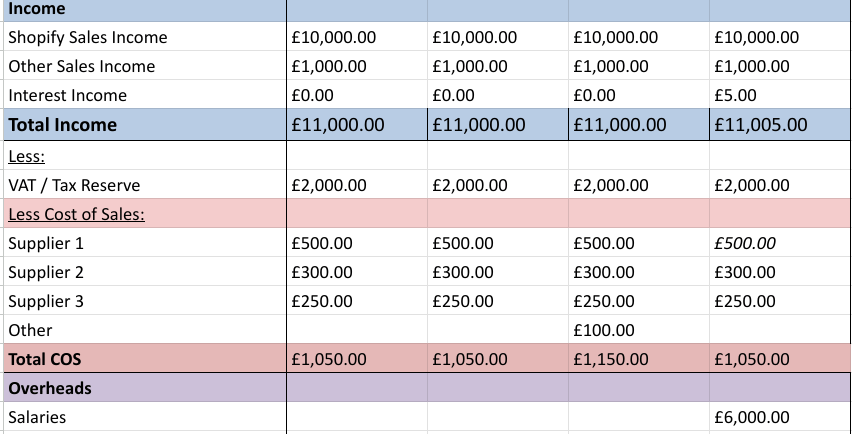5 Steps to Improving Ecommerce Cashflow
Cashflow problems are surprisingly common in ecommerce, yet they often remain undiscussed until they cause major headaches. While the ideal scenario is to plan ahead before any issues arise, reality doesn’t always cooperate. Fortunately, there are practical steps you can take right now.
Gary Baker


Fixing Cashflow in your Ecommerce Business
Cashflow problems in business - let’s face it, they’re as old as business itself. Yet in the world of ecommerce, where every decision can feel like it’s happening at speed, cashflow often slips under the radar until it’s too late. The reality is, whether you’re just getting started or have been running your store for years, poor cashflow management can sink your business before it even has a chance to flourish.
Ideally, you’d deal with cashflow issues long before they arise. In a perfect world, you’d have systems, processes, and rainy-day funds all sorted, ensuring that those inevitable bumps in the road don’t send you flying off course. Of course, real life is rarely so neat and tidy. Unexpected slow sales periods, marketing costs that overshoot the budget, late supplier deliveries, and VAT bills all hit at just the wrong time. The question then becomes: how can you best position yourself to manage your cashflow, no matter what challenges come your way?
Below are five practical steps that can help you get a handle on your finances right now. These strategies aren’t magic bullets, but they will go a long way towards making your ecommerce business more resilient and better prepared for whatever twists and turns lie ahead.
1) Create a Cashflow Forecast
It might sound dull, but one of the most important things you can do is to map out your cashflow for the next three months. A simple spreadsheet is all you need: break down your forecasted income, note down expected outgoings, and keep track of your projected bank balance on a weekly basis. This doesn’t have to be complicated. If you’re not sure where to start, there's a template at the bottom of this article you can use.
Why does this matter so much? Because having a clear picture of what’s coming in and going out gives you a fighting chance to address issues before they spiral. With a forecast, you’re not stumbling in the dark; instead, you’re guiding your business forward with the lights on.
2) Put Aside a Percentage of Your Income for VAT (and Other Taxes)
For many business owners, VAT time can trigger that sinking feeling - where is the money going to come from? The best way to avoid that panic is to create a separate bank account specifically for VAT. Each week, move a percentage of your income (20% is a safe bet) into this separate account. You’ll be grateful when the time comes to pay, and the funds are there waiting for you. Consider doing the same for corporation tax and PAYE. It’s all about discipline and not dipping into those funds even when you think it’s absolutely necessary.
3) Be Honest and Realistic
When you’re staring at a spreadsheet that suggests tough times ahead, it’s tempting to tweak the numbers to look a bit rosier. Don’t. The whole point of a cashflow forecast is to give you an early warning system. If you’re realistic, you can plan ahead, find solutions, and avoid nasty surprises. Cheating your own forecast only ensures you’ll be caught off guard later, which can compound the problem.
4) Don’t Ignore the Warning Signs
If cashflow problems are looming, sticking your head in the sand won’t help. In fact, pretending everything is fine almost guarantees more trouble down the line. The sooner you acknowledge the issue, the sooner you can take corrective action. For example, you could negotiate payment plans with suppliers, spread out costs, or run special promotions to give your sales a timely boost. The key is to do something, anything, rather than simply hoping it will all somehow sort itself out.
5) Learn from the Experience and Plan for the Future
Once you’ve wrestled your cashflow back into shape, it’s time to review what went wrong and ensure it doesn’t happen again. Where can you trim unnecessary costs? Can you hold less stock to free up cash? Is it time to review your advertising spend and make sure every pound is working its hardest? Should you set up separate accounts for wages, taxes, or other recurring outgoings?
These are not just “nice-to-do” actions. They’re the very steps that can keep your ecommerce business on solid financial ground, making it more resilient and better equipped to face the future.
Cashflow management isn’t the most glamorous aspect of running an online business, but it’s absolutely crucial. By tackling it head-on - mapping out forecasts, being disciplined with tax funds, remaining honest with yourself, addressing issues promptly, and learning from past mistakes - you’ll give your ecommerce business every chance to not just survive, but thrive. The sooner you make these steps a priority, the sooner you’ll start seeing the benefits.
(Get a free Cashflow template here)
Article by Gary Baker
Gary Baker is a UK-based ecommerce consultant, coach and investor with over 20 years experience running ecommerce businesses in a range of industries. He currently heads up Ecom180, a consulting firm focused on assisting ecommerce businesses with turnarounds, growth and exits. His extensive hands-on experience allows him to provide tailored advice based on firsthand knowledge of the difficulties and successes that come with running an ecommerce business today. You can find more about him at garybaker.online
